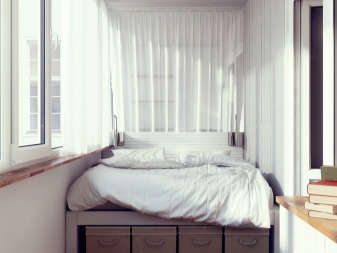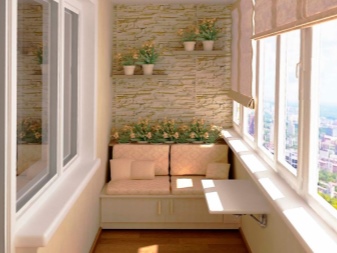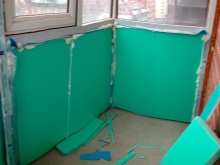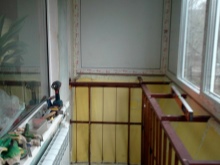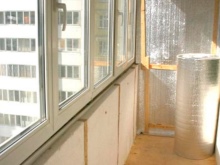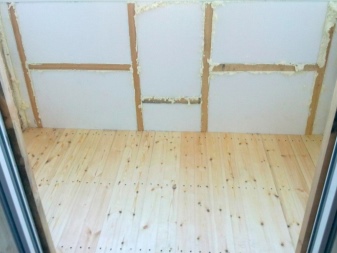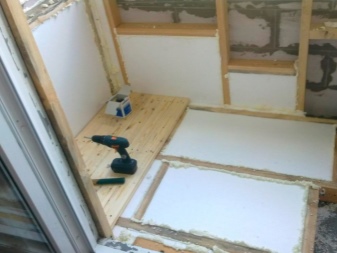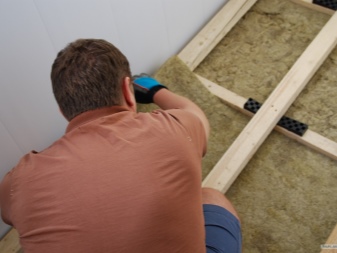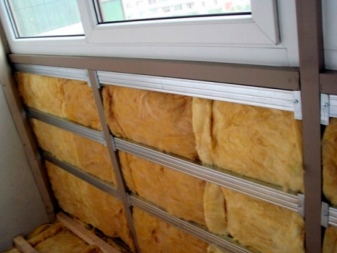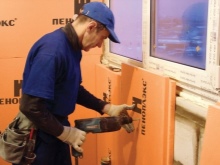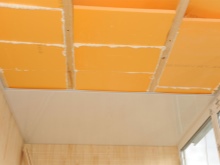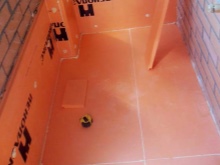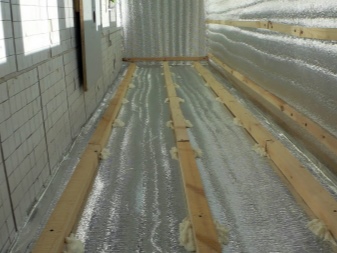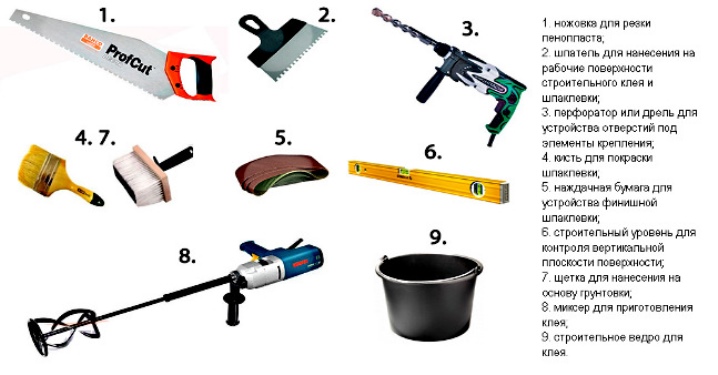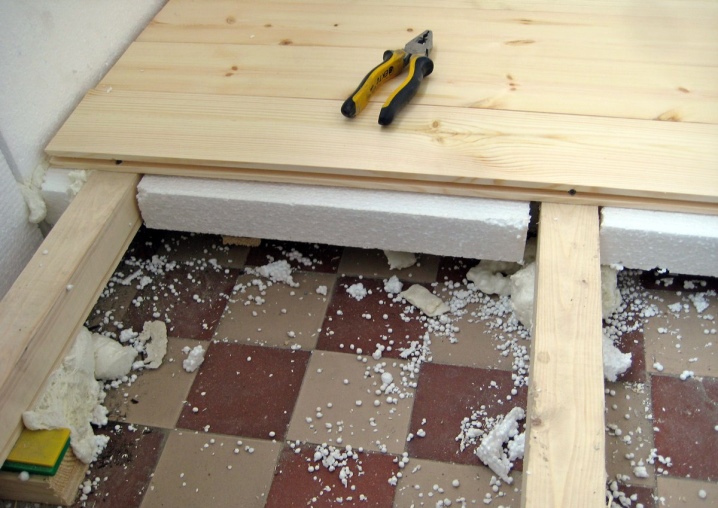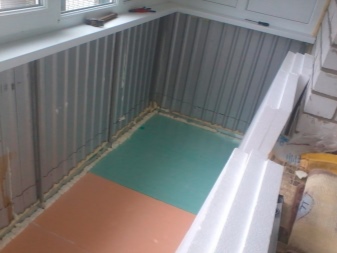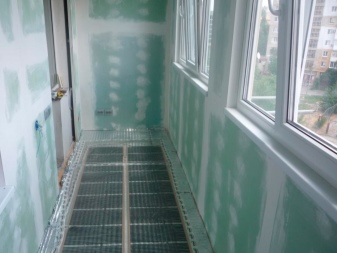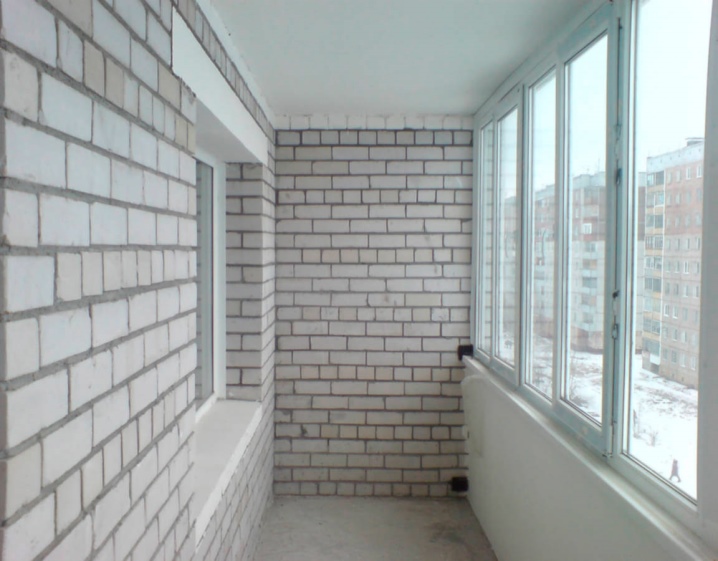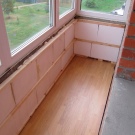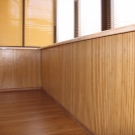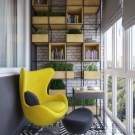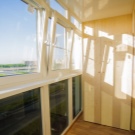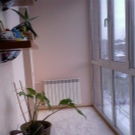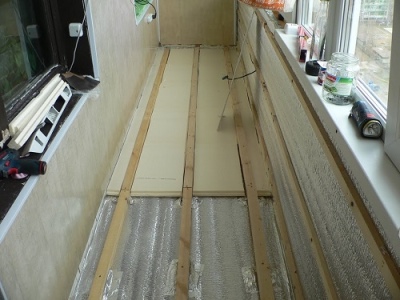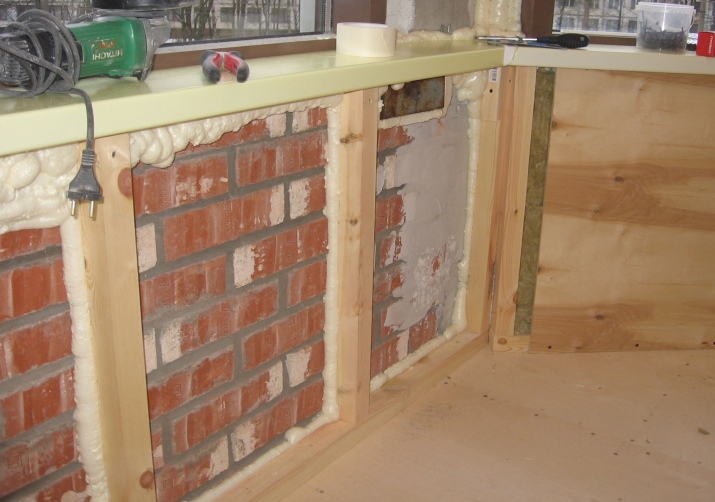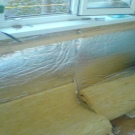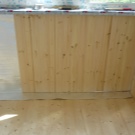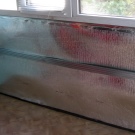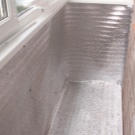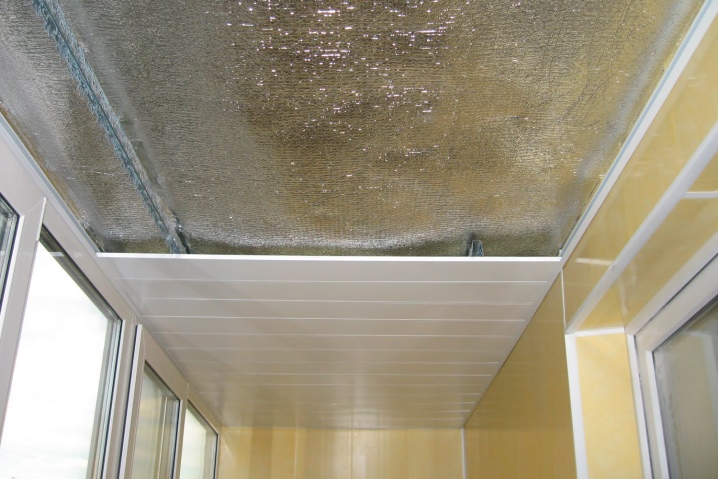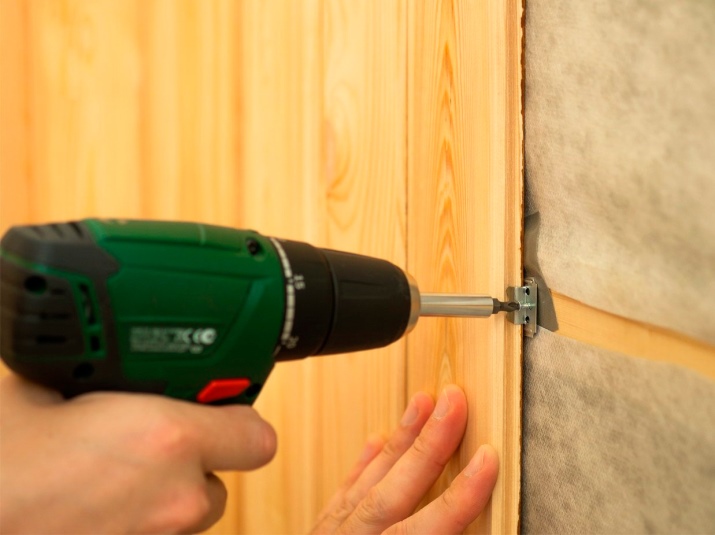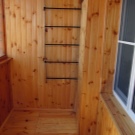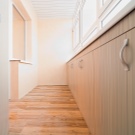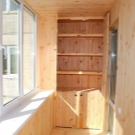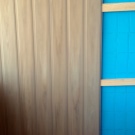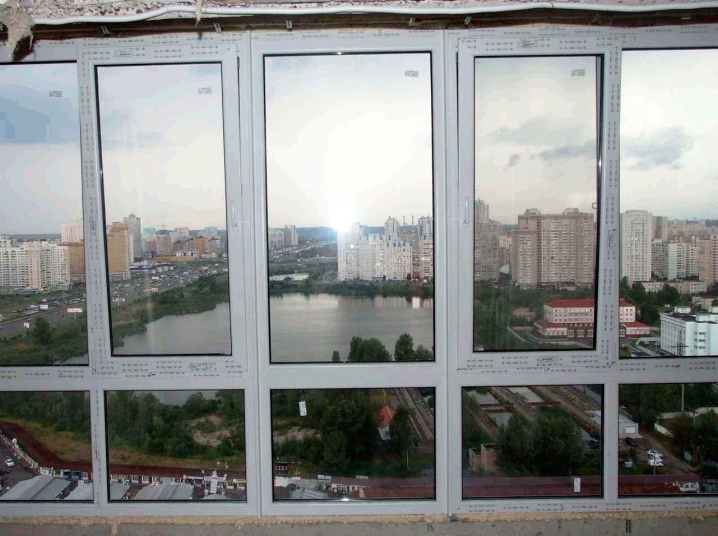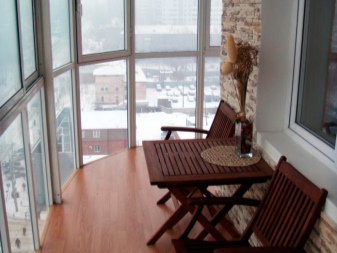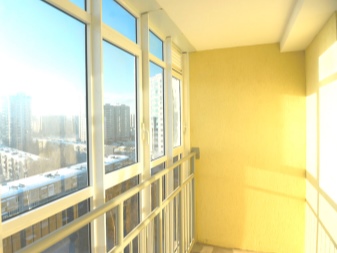Warming loggia and balcony do it yourself

The balcony will become an additional living room, if it is properly equipped. Before you start thinking through the interior and buying furniture, you need to warm the loggia. You can do it yourself without using professional equipment.
Material selection
For finishing loggias and creating insulation several types of materials are used. Before work is necessary to decide which of them will be more appropriate. They differ in price, performance and specificity of use.Popular heaters include:
Styrofoam
Foamed plastics of different density. The material is available in the form of square or rectangular plates. A distinctive feature of the foam is a long service life. Plastics are simple in processing and installation, even beginners can use them. The advantages of the material include low cost and the lowest thermal conductivity in the occupied market segment.
Mineral wool
Universal insulation produced from different types of melts - glass, volcanic and sedimentary. On this basis, the material is of three types: glass wool, stone and slag wool. An air layer is used as a heat insulator, with which the room is isolated from the cold. The material is produced in the form of rolls, plates or cylinders, which are simply amenable to cutting and processing.
The advantages of mineral wool include fire resistance, water resistance, resistance to aggressive chemical compounds and good sound insulation. In addition, the material is responsible for the continuous circulation of air and contributes to the maintenance of the microclimate inside the room.Another useful feature of the product is its environmental friendliness. Less resources are spent on the production of mineral wool, it does not release harmful compounds into the air.
Penoplex
Insulation, which is based on polystyrene. The material is produced by forcing plastics through a forming hole. Extruded polystyrene foam is produced in the form of rectangular plates of different colors.
Along the perimeter of the product is a chamfer, which simplifies the fit of the material and allows the elements to be laid as closely as possible to each other. Penoplex has a porous structure with small cells filled with gas and insulated with each other. At the expense of it good heat-insulating characteristics are reached: the heater can be used even in the conditions of severe winters.
The material weighs little, which simplifies its transportation and installation. The weight of the insulation can withstand even a light foundation; installation does not require the help of professionals. In addition, penoplex weighs little, and its service life can reach 50 years. The product does not rot and does not decompose, it is resistant to harmful microorganisms.
Foiled polyethylene foam
A layer of polyethylene, filled with gas and soldered to the foil. The universal multipurpose material which is keeping heat, absorbing moisture, reflecting steam and acting as a sound insulator. The product consists of several layers, one of which is made of aluminum and reflects up to 97% of heat.
The material is easy to handle and trim, weighs little. The small thickness of the product allows you to lay it both end to end and overlap. Polyethylene increases thermal efficiency twice, beating off another temperature.
Required tools
After the purchase of the material, they proceed to the selection of suitable equipment and inventory. Thermal insulation of the balcony does not require the use of complex tools that are difficult to access, and a beginner can do all the work.
For finishing loggias will be required:
- Hacksaw. Need for cutting materials.
- Glue gun. It is used for bonding elements.
- Putty knife. Used for applying glue and putty on work surfaces.
- Punch or drill. These tools cut holes for fasteners.
- Brush. It is used when you need to paint the putty.
- Sandpaper.Required for final surface treatment of insulation.
- Level. Controls the vertical plane of the surface.
- Brush. It is applied primer.
- Construction bucket. It bred glue.
- Wooden slats, metal corners. For processing edges of insulation, fitting plates.
- Screws, nails, dowels. They are used as fasteners.
- Construction stapler. Needed when installing and fixing materials. The length of the brackets is 10 mm.
- Polyurethane foam. It is used to close the slots and edges.
The list of tools varies depending on the selected material and features of the loggia.
When the balcony has an uneven floor, cement, sand, or finished leveling compounds can be applied before repairs. For measuring work, use a ruler or tape measure, and for the dilution of glue, you will need a construction bucket or other container that will not be soiled to be stained.
Preparatory work
Before proceeding directly to the weatherization of the balcony, you should remove all rubbish and dirt from the loggia. If old coatings are on the floor or walls, they must be removed. Also during the preparation it is necessary to divide the balcony into “cold” and “warm” zones.The first are walls and corners facing the street or bordering with other non-insulated surfaces. All other parts of the balcony are warm.
Based on this plan outlines for future work:
- Walls and corners bordering the street should be warmed with special care;
- If the balcony is bordered by a heated loggia, the partition between them can not be processed;
- The floor and ceiling are insulated regardless of the design and location of the balcony;
- The angles formed by the “warm” zones are not warmed.
Before insulation, it is recommended to coat the floor with a primer. So it will be possible to prevent the occurrence of mold and the reproduction of harmful microorganisms. On the unglazed loggias are often found through holes, holes and gaps. They are sealed with foam or special solutions to avoid heat loss and prolong the life of the insulation.
Loggia glazing
Glazing - a necessary step in the processing of the balcony. This will keep it warm, protect the room from wind, snow and rain and turn the loggia into a separate room. This procedure requires more effort than direct insulation, and for its implementation is recommended to turn to professionals. However, more experienced and self-confident repairmen are able to do it themselves.
There are several ways to glaze a balcony:
- Using wooden frames. The advantage of this method is the high quality of the materials used, strength, long service life and excellent external characteristics. Frames made of wood well suppress street noises, retain heat. Be careful with sliding constructions only. They are made in such a way that water can penetrate and ice up at a negative temperature.
- Frameless glazing. Guarantees protection against an atmospheric precipitation, adverse weather conditions. The design has a minimum of elements, each of which is of high quality and durability. When using this method, frames are not visible, because the windows look solid and more light penetrates. The disadvantages of the method include the high cost and the impossibility of full insulation loggia, because of what a loggia can be purged with strong gusts of wind.
- With the help of metal structures. The method is distributed due to good performance and relatively low cost.The system will maintain the temperature inside the room, ensure reliable air circulation. Plastic structures are more functional than wooden or other frames, because the balcony can be ventilated even in the cold season.
Systems have a long service life. Glazed in this way the balcony will last at least 40 years. The design contains drainage holes that minimize the risk of freezing frames. In addition, plastic is easier to care for - it does not require painting, it is easy to wash and clean.
- Aluminum glazing. One of the cheapest options. The design is easy, the load on the ceiling balcony is minimal. At the same time, materials are strong, durable and resistant to external mechanical stress. It is easy to take care of them, they are not afraid of moisture and high temperatures. Installation of the structure is carried out in a short time, people without experience will be able to make it.
How to insulate correctly from the inside: step by step instructions
On the balcony is required to handle three types of surfaces. It should start with the floor, then go to the walls and ceiling.Procedures for each of the zones are carried out in a similar way, but there are some differences in the tab layers.
Insulated floor consists of several layers:
- Waterproofing. It is placed on the concrete floor. For glazed balconies fit plastic film.
- Wooden logs. They are made of timber size 100x60 mm. Elements align on a plane, placing under them bars and wedges.
- Heat insulation material. Insulation fit in the space between the lags. It is important that the layers are tight to each other, and between them there were no gaps.
- Steam insulation film. It is mounted on a rough floor, which can be used as plywood.
The final coating is laid over the last layer, but this should be done after all repairs have been completed. Otherwise, the floor can be scratched, stained or incapacitated.
Warming of the walls begin with the installation of crates. In the case when repairs are made in a panel house, initially it is required to make the fence of the loggia solid, and only then proceed to repair work. The crate is assembled from a timber with dimensions of 40x40 or 50x50 mm.First, they have vertical elements and fix them with dowels, then connect them with transverse details. In the space between the crate, insulation is laid, then the vapor barrier film is attached.
The last stage - ceiling treatment:
- The cleaned surface is treated with antiseptic.
- The crate bars are nailed to the ceiling with screws or dowels with locking screws.
- Insulation is mounted using wood glue or foam.
- To create a vapor barrier fit polyethylene or foil film.
- If you want to install ceiling lighting, electrical wires are held.
- The design is sewn up with plastic or wood panels.
After warming balcony surfaces proceed to their finishing. At this stage, you can choose the original design, based on the color of the furniture, the destination of the future room and the presence of decorative elements. It is at this stage that an atmosphere of comfort is created, therefore the stage should be given special attention. If necessary, you can contact the professionals to create an original project.
Finish
The final stage of repair work is covering the walls.When finishing care about both the aesthetic characteristics of the balcony, and the protective functions. The balcony should be isolated from adverse environmental conditions and be comfortable for regular staying indoors. When installing, it is recommended to take bars with a thickness of no more than 2 cm. They are fixed so that there is a gap between them for finishing materials, for example, white sealant.
The final finish is made of several types of materials:
- Lining. Natural material with a natural color. Fixed with nails or a construction stapler. Lining is durable, wear-resistant, resistant to moisture. At the same time, it is quite expensive.
- Plastic panels. The material is easy to install, using the “liquid nails” method for installation. Plastic withstands temperature extremes and high humidity, does not require painting. Panel manufacturers offer a wide variety of colors. You can choose a panel, imitating wood or decorated with drawings.
- MDF. The material is a panel of pressed cardboard, covered with a special film. For fasteners of elements use clamps.The peculiarity of building materials is that it absorbs moisture well, therefore it is necessary to avoid contact with water.
We warm the panoramic loggia
Large windows, devoid of frames and partitions - an option for those who want to make a balcony with the original interior. Such glazing is more expensive and is a sign of elitism. Warming of the panoramic loggia is associated with a number of nuances, without which it is impossible to completely isolate the room and protect it from precipitation.
Processing the balcony with this type of glazing requires a lot of effort, because the work may require redevelopment of the space. This will require permission to make changes to the supporting structures. In addition, you may need the help of professionals: the work requires the use of special equipment.
The first step is to warm the floor. This is done before the installation of glass. So the thickness of insulation and other insulating layers will be chosen arbitrarily, without relying on the width of the windows. For the ceiling and walls, the thickness of the panels is not so critical, because you can deal with them at the last moment.
During the repair of the floor, several layers of materials are laid in, the procedure will be similar to the installation of elements on ordinary loggias. Changes begin after the installation of foiled insulation. At this stage, heating elements, thermoregulation sensors and electrical wires are placed on the floor. They must cover 70% of the surface and more; the distance from the wall is at least 50 mm. Next, the construction is poured with cement mortar 40-60 mm wide, a damping tape is placed around the perimeter (10x100 mm).
Typical mistakes
Many owners of balconies start their warming, not taking into account the many nuances of work. To extend the life of the finished loggia and make it as functional as possible, it is necessary to clearly outline the work plan and avoid typical mistakes during repairs.
- Loggia glazing on the brackets. During the work, the owners of the apartment can bring the frame for the glazing to the outside. In this case, a visor will appear along the perimeter of the loggia, on which snow will accumulate. Because of this, ice outgrowths appear on the facade of the building.
- Using a single layer of insulation. When installing foam blocks of 70-100 mm in thickness, many people neglect the need to insulate them additionally.This is a mistake, because even such laying can freeze through during prolonged cold weather and strong winds.
- Lack of vapor barrier. Without the use of such a layer, the material can dampen and spoil the surface on the balcony. In particular, it is dangerous in the case when the balcony is insulated with mineral wool. For the preservation of insulation, it is recommended to lay a layer of vapor barrier film.
- Use sealant without protection. Sealant foam quickly collapses under the influence of sunlight and high humidity. It may begin to bubble and spoil the appearance of the loggia. To avoid this, the repair should be cut off excess sealant, sand the edges and cover them with acrylic or putty.
- Warming "warm" zones. The wall between the apartment and the loggia does not require processing. Warming will not affect the temperature in the next room or on the balcony itself, and the procedure will be associated only with a waste of money.
Another mistake that can be made during the repair of a balcony is the lack of permission to work with load-bearing structures. When serious redevelopments are planned on the premises, this should be reported to the technical inventory bureau, which registers real estate objects.However, permission is not needed when, for example, double-glazed windows are installed on the balcony.
In conclusion, we offer you a short training video course on weatherization of a loggia or balcony.
